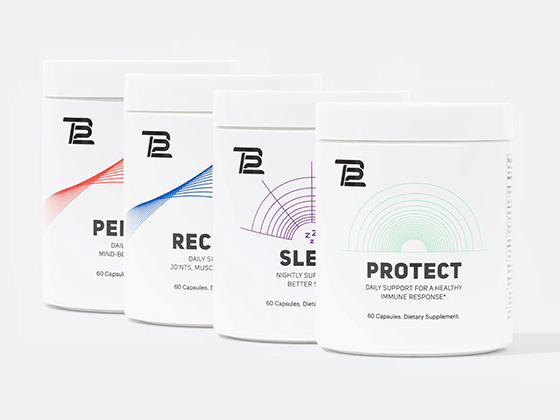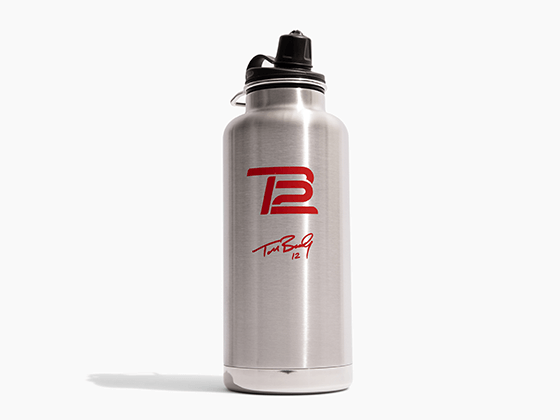IN THE PURSUIT of peak performance, too many of us zero in on the body and forget about the brain.
However, if you want to perform at a high level for as long as possible, training your brain is not just a helpful add-on — it’s essential. When we say, “train your brain,” we’re not talking about sudoku. And while mental exercises like meditation, deep breathing, and mantras are essential to building a winning mindset, right now we’re not talking about that either.
We’re talking about hacking the connection between your brain and your body from the ground up. To do this, we start with the muscles. The brain and the body are one integrated whole.
Why muscles?
The simple answer is that the muscles have a direct connection to the brain. If you’ve never thought about how your brain is connected to your body, it’s probably because they’re connected very well. In fact, the brain is connected so seamlessly to the rest of the body that it’s better to think of the brain and the body as one integrated whole. The sole reason the nervous system can do its job is just that: everything is connected.
People typically think of the brain as the control center of the body, and this is a pretty accurate picture. But what’s essential to understand is that the brain isn’t just calling the shots — it’s constantly learning from the rest of the body about what works and what doesn’t and solidifying these experiences as muscle memory.
This is important to us because it means we can use the muscles to send messages directly to the brain in a language it understands — Muscle trauma is the language of muscle memory. Whenever the brain gets out of its comfort zone, it experiences trauma. This trauma activates the connections between the muscles and the brain and says to the brain, “Hey, something weird just happened. Let’s change our approach so we can handle it next time.”
At TB12, we know we can use muscle trauma to our advantage.
That’s why we don’t see “trauma” as a bad thing all the time. We break muscle trauma down into two categories: negative-unintentional trauma & positive-intentional trauma. Pliability is about neuromuscular re-education.
Unlike massage, which is a passive activity, pliability training engages the muscles and educates them to do something new. Stretching merely preserves and augments range of motion, but pliability training actively strengthens connections between the muscles and the brain. During a pliability exercise, a physical therapist applies deep force to individual muscles while you, the athlete, rhythmically flex those muscles.
The deep force (50 to 100 Newtons) creates positive-intentional trauma, which sends a message to the brain that something weird and unfamiliar is happening. The brain then does what the brain does best: it learns. Specifically, it learns to keep the muscles long, soft, and primed for movement. As you stimulate the brain through repeated positive-intentional trauma in pliability exercises, it takes less and less neural input for your muscles to fire at full strength.
This is what we call neural priming — essentially giving your brain a heads-up to get ready for action. Whether you’re headed to the treadmill, the weight room, or the football field, when your muscles are primed your muscles are that much more ready to take on the negative-unintentional trauma that comes with activity.
Soft Tissue Mobilization
The short answer is that the evidence supports it. Below are some of the details. Keep in mind that whenever we say “soft-tissue mobilization,” we’re talking about what a physical therapist does when they knead your muscle tissue with their hands or with a tool.
Pliability exercises
For example, dynamic balance exercises and soft-tissue mobilization with an assisted device — have been shown to improve numerous symptoms in athletes with instability in their joints. In 2012, a study of athletes with chronic ankle instability found that dynamic balance-training exercises coupled with soft-tissue mobilization significantly increased the athletes’ control over their ankles (including range of motion) and reduced their pain. Soft-tissue mobilization through manual therapy has well-documented effects on muscle tissue. It lets your muscles fully relax and helps your tissues to repair and remodel themselves.
Can you do pliability work yourself?
Yes. The best method of pliability training is to get a self-pliability device and use it to work on targeted soft tissue mobilization before a round of functional, low-impact resistance training.
Positive and Negative Trauma?
What’s the difference? The main differences between positive-intentional trauma and negative-unintentional trauma are the why and the how: the purpose and the way it happens. Positive-intentional trauma, as the name suggests, is designed to help you. It’s “positive,” which means it provides a benefit. And it’s intentional, which means it doesn’t happen by accident.
Negative-unintentional trauma is also exactly what it sounds like. It’s what happens to your muscles when you get tackled by a lineman at full speed or when you’re running the stairs at Patriot Place and you miss one. Your muscles have the same exchange with your brain.
Muscles: “Hey, what just happened?”
Brain: “I don’t know. I think we fell down some stairs.”
Muscles: “Got it. Let’s figure out how to make sure this doesn’t happen again.”
Brain: “I got it! Let’s make our right calf and hamstring really tight for the next week.”
Muscles: “That should work. We’re on it.”
You can see where this is going. The problem with negative-unintentional trauma is that it’s not purposeful and we can’t control the result. Because it’s “unintentional,” it’s also unpredictable; as a result, it’s usually also unbalanced. This means that when our muscles and brain formulate their game plan, they leave out half their players and don’t even use the whole field.
In a way, pliability exercises train the brain and the muscles to create a balanced game plan. Because the trauma is balanced (both sides of the body getting the same treatment), the muscles of the entire body get re-trained together to fire at 100-percent. This positive-intentional trauma prepares the body to perform at its best and to handle negative-unintentional trauma when — not if — it happens.
You might be thinking that pliability is just a fancy word for stretching or massage. While both stretching and massage are helpful, pliability is a totally different ball game. Training your brain, training your body — they’re the same thing. At TB12, we help you train your brain from the ground up. Through targeted pliability and soft tissue mobilization, you can tell your brain what it needs to hear to keep your muscles in an optimal state — long, soft, and primed for movement — so you can keep your game strong.
Get Rolling.
Why does this matter? Pliability matters because it fills a gap in traditional sports training. The conventional way to train is to focus on strength and conditioning, training longer, and lifting more as you go. This almost inevitably leads to injury and rehabilitation, and the cycle repeats until the injury is too severe to fix. By training your brain to be a better handler of negative intentional trauma, pliability ends this vicious cycle; it complements your normal strength and conditioning routines so your workouts don’t put you at risk of injury.
References
Anguish, B., & Sandrey, M. A. (2018). Two 4-Week Balance-Training Programs for Chronic Ankle Instability. Journal of athletic training, 53(7), 662-671.
Hoch, M. C., Andreatta, R. D., Mullineaux, D. R., English, R. A., Medina McKeon, J. M., Mattacola, C. G., & McKeon, P. O. (2012). Two-week joint mobilization intervention improves self-reported function, range of motion, and dynamic balance in those with chronic ankle instability. Journal of orthopaedic research, 30(11), 1798-1804.







